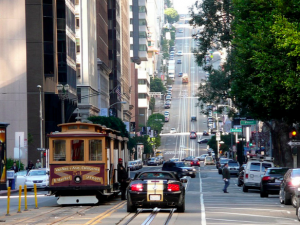Walking in San Francisco – Beautiful, But Look Both Ways
This Time Supes Swear They Will Fix The MUNI Overtime Problem San Francisco is, without question, one of the premier walking cities in the country – if not the world. Whether you stroll along the Embarcadero, across the Golden Gate Bridge or through the Mission, San Francisco’s streets, landmarks and unique neighborhoods lend themselves nicely to foot traffic.
But while the touristy vision of San Francisco as a walking haven still brings an abundance of people to our city, many San Franciscans may have a different perspective of what it means to walk in The City. That’s because there are more than 800 pedestrian crashes every year – that’s 2-3 people per day hit by a car as they walk.
This unfortunate statistic also has a fiscal component – $76 million a year. That’s the cost for injuries suffered by pedestrians, according to the Pedestrian Safety Advisory Committee. Pedestrians hit by cars who are admitted to hospitals rack up a roughly $80,000 bill and more than three quarters of that is paid for by the public.
For a city as advanced and innovative as San Francisco, one would assume City Hall is taking the necessary steps to correct this problem. One would be wrong. But, as District 6 Supervisor Jane Kim said, “pedestrian safety is not viewed as an urgent issue.” Kim understands the dangers first hand as her District 6 neighborhoods of SoMa and the Tenderloin have higher rates of pedestrian crashes than almost any other part of San Francisco.
We see how difficult it is for our city government to be proactive most of the time. Just recently we learned it takes longer to build a stoplight than it took to build AT&T Park. How can San Franciscans feel safe crossing the street knowing that, in the time it will take to put a stoplight in the ground, 2400 pedestrians will have been hit?
Groups like Walk San Francisco are working hard on our behalf, fighting for upgrades like wider sidewalks and improved street crossings. But we need to take our safety into our own hands. This is especially true given that, according to Walk San Francisco, the accident statistics aren’t readily accessible.
Cities across the country are using Gov 2.0 and Web 2.0 tools to make their streets safer for pedestrians through systems like SeeClickFix where people report problems as they see them. In San Francisco, the 311 system sees these reported issues and works to improve them. But they can only be improved and fixed if we do something about it and not wait for the next person.
So, next time you’re walking through your favorite San Francisco neighborhood minding your own business and a truck whizzes by going 20 miles per hour over the speed limit because the stop sign isn’t visible, take a picture, upload it, report it and make sure it gets fixed. This is a great walking city but 800 people per year getting hit while they walk is a step in the wrong direction.








